A β-catenin-driven switch in TCF/LEF transcription factor binding to DNA target sites promotes commitment of mammalian nephron progenitor cells
- PMID: 33587034
- PMCID: PMC7924951
- DOI: 10.7554/eLife.64444
A β-catenin-driven switch in TCF/LEF transcription factor binding to DNA target sites promotes commitment of mammalian nephron progenitor cells
Erratum in
-
Correction: A β-catenin-driven switch in TCF/LEF transcription factor binding to DNA target sites promotes commitment of mammalian nephron progenitor cells.Elife. 2021 Apr 29;10:e69853. doi: 10.7554/eLife.69853. Elife. 2021. PMID: 33913807 Free PMC article.
Abstract
The canonical Wnt pathway transcriptional co-activator β-catenin regulates self-renewal and differentiation of mammalian nephron progenitor cells (NPCs). We modulated β-catenin levels in NPC cultures using the GSK3 inhibitor CHIR99021 (CHIR) to examine opposing developmental actions of β-catenin. Low CHIR-mediated maintenance and expansion of NPCs are independent of direct engagement of TCF/LEF/β-catenin transcriptional complexes at low CHIR-dependent cell-cycle targets. In contrast, in high CHIR, TCF7/LEF1/β-catenin complexes replaced TCF7L1/TCF7L2 binding on enhancers of differentiation-promoting target genes. Chromosome confirmation studies showed pre-established promoter-enhancer connections to these target genes in NPCs. High CHIR-associated de novo looping was observed in positive transcriptional feedback regulation to the canonical Wnt pathway. Thus, β-catenin's direct transcriptional role is restricted to the induction of NPCs, where rising β-catenin levels switch inhibitory TCF7L1/TCF7L2 complexes to activating LEF1/TCF7 complexes at primed gene targets poised for rapid initiation of a nephrogenic program.
Keywords: TCF/LEF factors; Wnt signaling; developmental biology; kidney development; mouse; stem cells; transcriptional regulation.
© 2021, Guo et al.
Conflict of interest statement
QG, AK, BL, AR, HB, XC, NL, AB, LO, BR, AM No competing interests declared
Figures

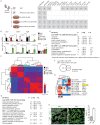
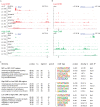
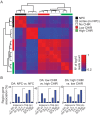


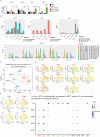
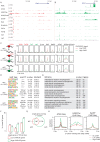

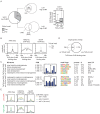

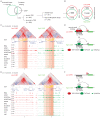
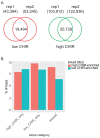
Similar articles
-
Dose-dependent responses to canonical Wnt transcriptional complexes in the regulation of mammalian nephron progenitors.Development. 2024 Sep 15;151(18):dev202279. doi: 10.1242/dev.202279. Epub 2024 Sep 30. Development. 2024. PMID: 39250420 Free PMC article.
-
Six2 and Wnt regulate self-renewal and commitment of nephron progenitors through shared gene regulatory networks.Dev Cell. 2012 Sep 11;23(3):637-51. doi: 10.1016/j.devcel.2012.07.008. Epub 2012 Aug 16. Dev Cell. 2012. PMID: 22902740 Free PMC article.
-
Canonical Wnt transcriptional complexes are essential for induction of nephrogenesis but not maintenance or proliferation of nephron progenitors.bioRxiv [Preprint]. 2023 Aug 21:2023.08.20.554044. doi: 10.1101/2023.08.20.554044. bioRxiv. 2023. PMID: 37662369 Free PMC article. Preprint.
-
Cell-context dependent TCF/LEF expression and function: alternative tales of repression, de-repression and activation potentials.Crit Rev Eukaryot Gene Expr. 2011;21(3):207-36. doi: 10.1615/critreveukargeneexpr.v21.i3.10. Crit Rev Eukaryot Gene Expr. 2011. PMID: 22111711 Free PMC article. Review.
-
WNT/beta-catenin signaling in nephron progenitors and their epithelial progeny.Kidney Int. 2008 Oct;74(8):1004-8. doi: 10.1038/ki.2008.322. Epub 2008 Jul 16. Kidney Int. 2008. PMID: 18633347 Free PMC article. Review.
Cited by
-
Regulation of nephron progenitor cell lifespan and nephron endowment.Nat Rev Nephrol. 2022 Nov;18(11):683-695. doi: 10.1038/s41581-022-00620-w. Epub 2022 Sep 14. Nat Rev Nephrol. 2022. PMID: 36104510 Free PMC article. Review.
-
Wnt signaling mediates acquisition of blood-brain barrier properties in naïve endothelium derived from human pluripotent stem cells.Elife. 2021 Nov 10;10:e70992. doi: 10.7554/eLife.70992. Elife. 2021. PMID: 34755601 Free PMC article.
-
Understanding the development of oral epithelial organs through single cell transcriptomic analysis.Development. 2022 Aug 15;149(16):dev200539. doi: 10.1242/dev.200539. Epub 2022 Aug 17. Development. 2022. PMID: 35831953 Free PMC article.
-
Escin Activates Canonical Wnt/β-Catenin Signaling Pathway by Facilitating the Proteasomal Degradation of Glycogen Synthase Kinase-3β in Cultured Human Dermal Papilla Cells.Curr Issues Mol Biol. 2023 Jul 14;45(7):5902-5913. doi: 10.3390/cimb45070373. Curr Issues Mol Biol. 2023. PMID: 37504289 Free PMC article.
-
Mapping the transcriptional and epigenetic landscape of organotypic endothelial diversity in the developing and adult mouse.Nat Cardiovasc Res. 2025 Apr;4(4):473-495. doi: 10.1038/s44161-025-00618-0. Epub 2025 Mar 17. Nat Cardiovasc Res. 2025. PMID: 40097733 Free PMC article.
References
-
- Adam RC, Yang H, Ge Y, Lien WH, Wang P, Zhao Y, Polak L, Levorse J, Baksh SC, Zheng D, Fuchs E. Temporal layering of signaling effectors drives chromatin remodeling during hair follicle stem cell lineage progression. Cell Stem Cell. 2018;22:398–413. doi: 10.1016/j.stem.2017.12.004. - DOI - PMC - PubMed
Publication types
MeSH terms
Substances
Associated data
- Actions
Grants and funding
LinkOut - more resources
Full Text Sources
Other Literature Sources
Medical
Molecular Biology Databases

